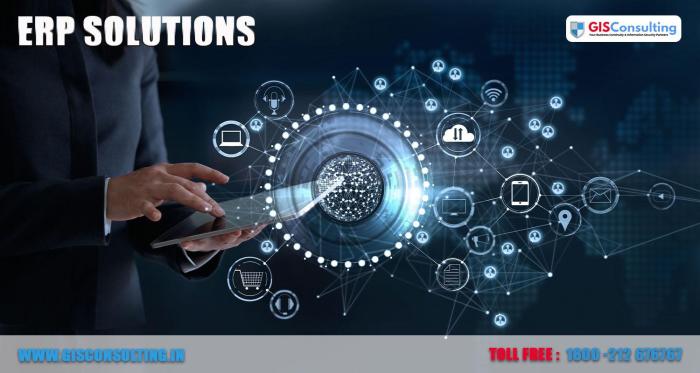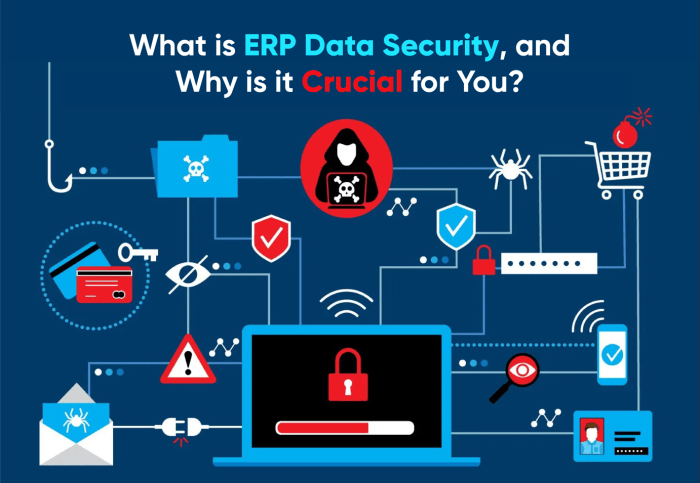How to manage data security with ERP apps is a critical concern for any organization that relies on these systems for its core operations. ERP systems are the heart of many businesses, housing sensitive financial data, customer information, and operational processes. This means that securing ERP data is not just a matter of compliance but also a vital step in protecting your organization’s reputation, profitability, and overall success.
Understanding the unique vulnerabilities of ERP systems is crucial. These systems are complex and often interconnected with other applications, making them susceptible to various threats. From data breaches to unauthorized access, the potential risks are significant. This article explores a comprehensive approach to managing data security within ERP applications, covering key security controls, policies, and best practices.
Understanding Data Security in ERP Apps
ERP systems, designed to streamline business processes, store a vast amount of sensitive data, making them prime targets for cyberattacks. Understanding the unique data security challenges posed by these systems is crucial for safeguarding your business.
Types of Data Stored in ERP Applications
ERP applications store a diverse range of critical data, including:
- Financial Data: Financial records, invoices, payments, and bank account details.
- Customer Data: Customer contact information, purchase history, and preferences.
- Employee Data: Payroll information, benefits, and performance records.
- Inventory Data: Stock levels, purchase orders, and supplier information.
- Production Data: Manufacturing schedules, production processes, and quality control records.
This data is essential for business operations and can be highly valuable to attackers.
Potential Risks and Vulnerabilities
ERP systems are susceptible to various risks and vulnerabilities, including:
- Unauthorized Access: Weak passwords, lack of multi-factor authentication, and unpatched vulnerabilities can allow unauthorized access to sensitive data.
- Data Breaches: Malware infections, phishing attacks, and social engineering can compromise ERP systems, leading to data theft.
- Data Loss: Accidental deletion, hardware failures, and natural disasters can result in the loss of critical data.
- Data Corruption: Errors in data entry, software bugs, and system malfunctions can lead to data corruption, compromising data integrity.
- Non-compliance with Regulations: Failure to comply with data privacy regulations, such as GDPR and HIPAA, can result in significant fines and reputational damage.
These risks highlight the importance of robust data security measures to protect ERP systems and the valuable data they contain.
Implementing Data Security Measures

Once you understand the nature of data security in ERP apps, you need to implement effective measures to protect your sensitive information. This involves establishing a comprehensive security framework that incorporates various controls, access management mechanisms, and encryption practices.
Access Control Mechanisms
Access control is crucial for ensuring that only authorized personnel can access specific data within your ERP system. This involves implementing mechanisms that restrict access based on user roles and responsibilities.
- Role-Based Access Control (RBAC): This is a common approach where users are assigned roles, and each role is granted specific permissions to access different modules, data, and functionalities. For instance, a sales representative might have access to customer data and sales orders, while an accountant might have access to financial records and reports. This approach simplifies administration and ensures that users only access information relevant to their tasks.
- Least Privilege Principle: This principle dictates that users should only be granted the minimum level of access required to perform their duties. This helps minimize the risk of unauthorized data access or modification. For example, a junior employee might have read-only access to customer data, while a senior manager might have read, write, and delete privileges.
- Two-Factor Authentication (2FA): This adds an extra layer of security by requiring users to provide two forms of authentication, such as a password and a one-time code generated by a mobile app or email. This makes it significantly harder for unauthorized individuals to gain access to the ERP system, even if they have a stolen password.
Data Encryption and Secure Storage
Data encryption is a fundamental aspect of protecting sensitive information within your ERP system. Encryption transforms data into an unreadable format, making it inaccessible to unauthorized individuals. Secure data storage practices ensure that data is stored in a manner that minimizes the risk of unauthorized access, data breaches, and data loss.
- Data Encryption at Rest: This involves encrypting data while it is stored on hard drives, servers, and other storage devices. This protects data from unauthorized access even if the storage device is physically stolen or compromised. Modern ERP systems often incorporate built-in encryption capabilities, or you can leverage third-party encryption solutions.
- Data Encryption in Transit: This is essential for protecting data while it is being transmitted between different components of the ERP system, such as between the user’s computer and the ERP server. This can be achieved using Secure Sockets Layer (SSL) or Transport Layer Security (TLS) protocols, which establish encrypted connections to protect data from eavesdropping or interception during transmission.
- Secure Data Storage Practices: This includes using physically secure data centers with access controls, robust firewalls, intrusion detection systems, and regular backups. It’s also crucial to implement strong password policies, enforce regular security audits, and ensure compliance with relevant data privacy regulations, such as GDPR or CCPA.
Data Security Policies and Procedures
Data security policies and procedures are crucial for safeguarding sensitive information within your ERP system. They provide a framework for managing user access, incident response, and overall data protection. By implementing a comprehensive approach, you can minimize risks and maintain data integrity.
Data Security Policy Design
A comprehensive data security policy for ERP applications should address various aspects of data protection. This policy serves as a guiding document for all users and stakeholders involved in managing and accessing ERP data.
- Data Classification: Establish a classification system for different types of data stored in the ERP system. This allows you to prioritize security measures based on sensitivity levels. For example, financial data might require stricter access controls than general employee information.
- Access Control: Implement robust access control mechanisms to restrict access to data based on user roles and responsibilities. This principle of least privilege ensures that users only have access to the information they need to perform their tasks.
- Data Encryption: Encrypt sensitive data both in transit and at rest. Encryption helps protect data from unauthorized access even if the system is compromised.
- Data Backup and Recovery: Establish a regular data backup and recovery plan. This ensures data availability in case of system failures, disasters, or security breaches.
- Security Awareness Training: Provide regular security awareness training to all users. This training should cover topics like phishing scams, password security, and best practices for handling sensitive information.
- Data Retention Policy: Define clear data retention policies to determine how long different types of data should be stored. This helps minimize the risk of storing unnecessary data and reduces the potential attack surface.
User Access and Permissions Management
Managing user access and permissions is a critical aspect of data security. A well-defined procedure ensures that only authorized individuals can access sensitive information.
- Role-Based Access Control (RBAC): Implement RBAC to assign specific roles to users, granting them access to only the data and functionalities relevant to their roles. This simplifies access management and reduces the risk of unauthorized access.
- User Account Management: Establish a process for creating, modifying, and disabling user accounts. This includes assigning unique usernames and strong passwords, and regularly reviewing account permissions.
- Password Policies: Enforce strong password policies that require users to choose complex passwords and change them regularly. Consider using multi-factor authentication for sensitive accounts.
- User Activity Monitoring: Monitor user activity within the ERP system to identify suspicious patterns or potential security threats. This includes tracking login attempts, data access, and system changes.
Incident Response and Data Breach Handling
Having a well-defined incident response plan is crucial for minimizing the impact of security breaches. A robust plan Artikels the steps to be taken in case of a data breach.
- Incident Response Team: Establish an incident response team responsible for handling security incidents and breaches. This team should include individuals with expertise in security, IT, and legal matters.
- Incident Reporting: Define a clear process for reporting security incidents. This includes identifying the nature of the incident, the affected systems, and the potential impact.
- Incident Containment: Implement measures to contain the incident and prevent further damage. This might involve isolating affected systems, disabling user accounts, or blocking malicious traffic.
- Data Breach Notification: Develop a process for notifying affected individuals and relevant authorities in case of a data breach. This includes providing information about the nature of the breach, the affected data, and the steps taken to mitigate the impact.
- Post-Incident Review: Conduct a thorough post-incident review to identify the root cause of the breach and implement corrective actions to prevent similar incidents in the future.
Role of Technology in Data Security: How To Manage Data Security With ERP Apps

Technology plays a crucial role in securing data within ERP systems, offering multiple layers of protection against potential threats. By leveraging various security tools and measures, organizations can significantly enhance the integrity and confidentiality of their sensitive data.
Firewalls, Intrusion Detection Systems, and Anti-Malware Software
Firewalls, intrusion detection systems (IDS), and anti-malware software are essential components of a comprehensive data security strategy.
- Firewalls act as a barrier between the ERP system and the external network, blocking unauthorized access and preventing malicious traffic from entering the system. They analyze incoming and outgoing network traffic, allowing only authorized connections to pass through.
- Intrusion Detection Systems (IDS) monitor network traffic for suspicious activities and patterns that may indicate an intrusion attempt. When an anomaly is detected, the IDS alerts administrators, enabling them to take immediate action to mitigate the threat.
- Anti-malware software protects the ERP system from malware, such as viruses, worms, and ransomware. It scans for and removes malicious software, preventing it from infecting the system and compromising data.
Data Loss Prevention (DLP) Tools
Data Loss Prevention (DLP) tools are designed to identify and prevent sensitive information from leaving the organization’s control.
- DLP tools monitor data in real-time, analyzing content for specific s, patterns, and sensitive data types.
- When a potential data leak is detected, the DLP tool can take actions such as blocking the transmission, alerting administrators, or encrypting the data.
- DLP solutions can be implemented at various levels, including network, endpoint, and application layers, providing comprehensive protection across the organization.
Encryption for Data Transmission
Encryption is a crucial security measure that transforms data into an unreadable format, making it incomprehensible to unauthorized individuals.
- Encryption ensures that even if data is intercepted during transmission, it cannot be accessed or understood without the appropriate decryption key.
- This is particularly important for sensitive data such as customer information, financial records, and intellectual property, which could be vulnerable to unauthorized access during transmission over the internet or through insecure networks.
- Modern ERP systems typically employ encryption protocols like TLS/SSL to secure data transmission, ensuring that data remains confidential and protected throughout its journey.
User Awareness and Training
A crucial aspect of data security in ERP systems is user awareness and training. By educating users on data security best practices, organizations can significantly reduce the risk of data breaches and ensure compliance with relevant regulations.
Creating a Training Program
A comprehensive training program should cover various aspects of data security, tailored to the specific roles and responsibilities of users within the organization.
- Data Security Fundamentals: Explain basic concepts such as confidentiality, integrity, and availability of data, and how these principles apply to ERP systems.
- Data Access Control: Emphasize the importance of only accessing data that is relevant to their job responsibilities and understanding the consequences of unauthorized access.
- Password Management: Teach users how to create strong passwords, avoid sharing them, and change them regularly.
- Phishing and Social Engineering: Explain the risks of phishing attacks and how to identify and avoid them. Users should be trained to recognize suspicious emails and websites and report them to the appropriate authorities.
- Data Backup and Recovery: Explain the importance of regular data backups and how to restore data in case of a disaster or data loss.
- Incident Reporting: Train users on how to identify and report suspicious activities related to data security, such as unauthorized access attempts or data breaches.
Designing a Checklist for Employees
A checklist provides employees with a structured approach to handling sensitive data, ensuring they follow best practices consistently.
- Verify User Access: Ensure that all users accessing sensitive data have the appropriate authorization and permissions.
- Secure Data Storage: Always store sensitive data in secure locations, such as encrypted databases or password-protected folders.
- Data Encryption: Encrypt sensitive data both in transit and at rest to protect it from unauthorized access.
- Secure Data Sharing: Use secure methods like encrypted email or file transfer protocols when sharing sensitive data externally.
- Data Disposal: Properly dispose of sensitive data, either by secure deletion or physical destruction, to prevent unauthorized access.
- Regular Security Audits: Conduct regular security audits to identify and address any vulnerabilities or weaknesses in the data security system.
Identifying and Reporting Suspicious Activities
Empowering employees to identify and report suspicious activities is crucial for maintaining data security.
- Unusual Login Attempts: Report any unusual login attempts, such as multiple failed logins or attempts to access data outside of normal working hours.
- Suspicious Emails or Websites: Report any suspicious emails or websites that appear to be phishing attempts or contain malware.
- Unauthorized Data Access: Report any instances of unauthorized data access or attempts to modify or delete data.
- Data Breaches: Report any suspected data breaches immediately to the appropriate authorities.
Continuous Monitoring and Evaluation

Continuous monitoring and evaluation are crucial for maintaining the effectiveness of data security measures within your ERP system. Proactive measures like regular security audits and vulnerability assessments, along with monitoring user activity and updating security policies, are essential to identify and address potential vulnerabilities before they can be exploited.
Regular Security Audits and Vulnerability Assessments
Regular security audits and vulnerability assessments are critical for identifying and mitigating security risks within your ERP system. These assessments should be conducted at least annually, or more frequently if significant changes are made to the system or its configuration.
- Security Audits: These comprehensive evaluations assess the overall security posture of your ERP system, including the physical security of data centers, network infrastructure, and user access controls. They can help identify weaknesses in security policies, procedures, and controls.
- Vulnerability Assessments: These scans identify specific vulnerabilities in your ERP system, such as outdated software, weak passwords, or misconfigured security settings. They help pinpoint potential entry points for attackers and allow you to prioritize remediation efforts.
Monitoring User Activity and Detecting Unusual Patterns
Monitoring user activity within your ERP system is essential for detecting potential security breaches and identifying suspicious behavior. Implementing a system for logging and analyzing user actions can help you identify unusual patterns, such as unauthorized access attempts, data manipulation, or excessive data downloads.
- User Activity Logs: These logs should record all user actions within the ERP system, including login attempts, data access, file downloads, and system modifications. These logs can be invaluable for forensic investigations and incident response.
- Anomaly Detection: Using advanced analytics and machine learning, you can monitor user activity for unusual patterns that may indicate malicious activity. For example, a sudden increase in data access from an unusual location or time of day could be a red flag.
Implementing a System for Reviewing and Updating Security Policies, How to manage data security with ERP apps
Security policies should be regularly reviewed and updated to reflect changes in technology, threats, and business requirements. Establishing a formal process for policy review and update ensures that your security measures remain relevant and effective.
- Regular Policy Reviews: Policies should be reviewed at least annually, or more frequently if significant changes occur within the organization or the threat landscape.
- Policy Update Process: Establish a clear process for updating security policies, including stakeholder involvement, documentation, and communication. This process should ensure that changes are properly implemented and communicated to all relevant parties.
By implementing a robust data security strategy, organizations can effectively mitigate risks and ensure the integrity of their ERP data. This includes establishing strong access controls, implementing data encryption, conducting regular security audits, and fostering a culture of data security awareness among users. Remember, data security is an ongoing process that requires continuous monitoring, adaptation, and improvement. By staying vigilant and proactive, organizations can confidently navigate the evolving data security landscape and protect their valuable assets.
FAQ Corner
What are the most common ERP data security threats?
Common threats include unauthorized access, data breaches, malware infections, insider threats, and data loss.
How can I ensure my ERP data is encrypted?
Implement encryption at rest (for data stored on servers) and in transit (for data transmitted over networks). Consider using encryption tools specifically designed for ERP systems.
What is the role of user awareness in ERP data security?
User awareness is critical. Train employees on data security best practices, including strong password creation, recognizing phishing attempts, and reporting suspicious activity.